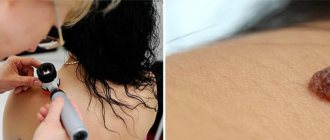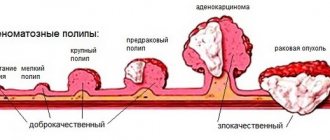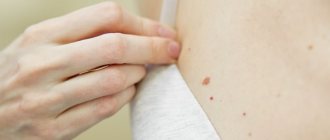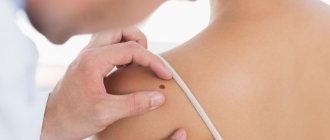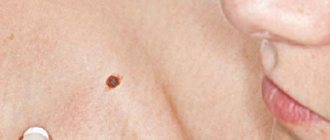All people, and especially women, dream of ideal beauty. I want the skin to be even, smooth, without any blemishes on the face or redness and rashes on the body. How to react to new growths, should you sound the alarm or calmly observe the changes? Red dots on the skin of the abdomen, which have never been there before, can signal various problems in the body. It is especially important to find out why they appear?
Causes of red moles on the body
By its nature, a red mole is a cluster of vessels and capillaries, which normally perform the function of oxygen and nutritional supply to the epidermal structures. With the development of any internal pathological process or under the influence of exogenous factors, small vessels can connect, forming a kind of bundle, which in medicine is often called an angioma.
When asked by a patient regarding small red moles, “What is this?”, the specialist will most often answer – angioma. Typically, these pigmented formations are formed during the period of active growth of the body, that is, in early childhood, which is associated with a serious transformation of the human vascular system at this age.
A distinctive feature of red pigmented nevi is the loss of color intensity of the formation when pressing on it, which is associated with a vascular reaction. In addition, red moles normally do not hurt or itch, and do not change their shape and size over time.
The following etiotropic factors may be the causes of angiomas in adult patients:
- Excessive sun exposure (excessive ultraviolet radiation);
- Hormonal imbalance (puberty, pregnancy, menopause, etc.);
- Pathologies of the gastrointestinal tract, especially the pancreas;
- Injuries and mechanical damage to the epidermal integument;
- Diseases of the cardiovascular system;
- Violation of the formation or destruction of pigmented cells.
Today, doctors do not give a clear answer regarding the causes of red moles on the body, however, the factors listed above can become a provoking condition for their appearance.
Elimination methods
Self-diagnosis, compiling a history of the disease together with the attending physician, consultation with a competent specialist, laboratory tests - these are the actions that will most reliably help establish the true cause of the disease.
Red dots on the back, stomach, legs and other surfaces will disappear if treatment is correctly prescribed for the disease that caused these formations.
| Cause | Elimination method |
| Mechanical impact (epilation, microtrauma, etc.) | Use healing ointments or creams, and as a preventive measure, try to avoid injuries. If this is the result of hair removal, choose other shaving products and purchase effective cosmetics after this procedure. |
| Vitamin deficiency | Take complexes rich in essential vitamins. And also eating foods rich in those vitamins that the body lacks. |
| Hemangioma | Eliminate a benign tumor by contacting a doctor: laser, surgery, cauterization. The branches of hemangiomas are removed by tying off the branches and removing large trunks. |
| Liver diseases | Detoxification using medications prescribed by specialists. Therapeutic nutrition (excluding alcohol, salts, and excessive fluid intake from the diet), limiting physical activity, and controlling body weight are additional ways that have a beneficial effect on the process of getting rid of spots. |
| Gastrointestinal diseases | Diet, therapy aimed at relieving pain and regulating the normal functioning of the stomach, intestines, pancreas and other organs. |
| Rheumatoid problems | Drug treatment, physiotherapy, lifestyle changes. |
Types of red moles
The appearance of red moles on the body can be accompanied by various visual characteristics of the defect. Such epidermal formations can be either flat, forming in the deep dermal layers, or have a superficial nature, protruding above the skin. Moreover, according to the nature of the visual picture, all angiomas are usually divided into two groups:
- Spot. The pigmented area has clear red borders and is a point at which a collection of vessels and capillaries is concentrated. Often, punctate angiomas are multiple in nature, manifesting themselves in the form of specific “rashes” on the patient’s skin.
- Star-shaped. Such moles are a collection of tiny thin vessels that are visible through the epidermis and converge at a central point, forming a kind of star. These structures are also associated with diseases such as rosacea.
In addition, a separate group includes especially large red moles on the body - hemangiomas, which usually significantly spoil the patient’s appearance and require cosmetic correction.
Associated symptoms
Some red spots on the hands do not itch and are not accompanied by additional symptoms, that is, they do not bother a person in any way. For this reason, the patient consults a doctor when the pathology has already become chronic. Among such ailments are skin hemangioma, vitamin deficiency, impaired functionality of blood vessels, and syphilis. The latter disease does not cause inflammation of the epidermis for a long time, but there are ulcers and fever.
Infections can almost always be recognized by characteristic symptoms, which are divided into local and general. The first group easily includes rashes of various types, itching and burning, peeling, the appearance of crusts on the surface or weeping wounds. The second group includes fever, the appearance of weakness and apathy, sore throat and head, loss of appetite or sleep disturbance. In addition, it is possible to enlarge the lymph nodes, which are located closer to the red spots on the body.
Why are red moles dangerous?
If a red mole does not bother its owner and does not change its external characteristics, it can be argued that such a formation does not pose a significant threat to the health and life of the patient. At the same time, you should get professional medical advice and resort to modern therapeutic methods if you have the following manifestations:
- The red mole grows or changes its shape;
- The patient experiences pain, itching or burning in the area where the pigmented formation is located;
- The mole is bleeding;
- Superficial structures or ulcerations appear;
- There are more than 6 small red dots in one area of the body.
All these symptoms may indicate the development of an oncological process. In addition, the category of dangerous moles includes angiomas located in places where they can be easily injured when wearing clothes, shoes, jewelry, etc. Mechanical damage to such a formation can provoke the appearance of new red moles on the body, activate malignant transformation and leave scars or scars on the skin.
Folk remedies
The use of folk recipes to get rid of red spots on the stomach should be carried out with great caution, because Without taking into account the reason for their appearance, you can not improve the condition, but harm the body.
Under no circumstances should you use methods that are aimed at eliminating red dots on your own (tearing off, removing, cauterizing, etc.)
The safest thing to do is to lighten the red dots to make them less noticeable. The easiest way is to alternately apply cotton swabs soaked in lemon and garlic juice. Onion, dandelion or pineapple juice will also help fade the redness of the spots. In any case, when turning to the advice of traditional healers, be extremely careful.
Medical correction of red moles
The doctor, after conducting an initial examination and the necessary diagnostic measures, will make a conclusion regarding the likelihood of malignancy of the red mole. Based on this diagnosis, a strategy for further therapeutic actions is developed. If a red mole does not pose an oncological threat and is located in a closed area of the body, its removal is not necessary.
In cases where the red nevus causes aesthetic or physiological discomfort to the patient, it can be removed using modern hardware techniques, the priority among which is laser destruction. This method of removing red moles guarantees painlessness and safety for the patient, and also has a low level of trauma.
Medical offers its patients the latest expert-class medical equipment that meets the most stringent European standards. Effective therapy, high-quality medical service and affordable prices are the main principles of our clinic.
Find out the cost of the procedure “Removal of tumors”
Preventive measures
After successful therapy, simple rules should be followed. They will help maintain remission for a long time, as well as prevent other pathologies. Recommendations to remember if you have sores on your body:
- sunbathe only in the morning or evening, when ultraviolet rays are not so active;
- do not forget to use sunscreen;
- regularly moisturize the skin (especially in summer and winter) using suitable care products;
- Drink enough fluids per day to avoid dehydration;
- arrange fasting days, cleansing the intestines and liver of toxins;
- visit doctors in a timely manner, identifying health problems;
- monitor moles, angiomas and hemangiomas of the skin, paying attention to their size and color.
Red dots can signal an allergy or a serious problem in the body, and can also be a reaction to stress. If painful spots on the body spread and itch, it is better to immediately consult a specialist. Often, pimples are not something serious and disappear on their own.
You can ask your question to our author:
Sun safety rules
- Try not to sunbathe during the most active solar radiation, from 10-11 to 16 hours.
- Before going to the beach, it is advisable not to use deodorants, creams, or perfumes.
- Be sure to use sunscreens with a high protection factor.
- Before sunbathing, avoid foods that may cause photoallergic reactions.
- If possible, wear clothing that protects from active solar radiation. If a person is confirmed to have solar urticaria, they are advised to avoid exposure to sunlight and wear clothing and hats that protect from sunlight.
- If skin manifestations occur, contact a specialist.
Red dots for liver diseases
Pinpoint rashes can signal serious liver problems. In these cases, two types of elements are distinguished:
- Hepatic spider veins.
- Hepatic purpura.
Spider veins look like red dots with branches resembling spider legs (see photo below). As a rule, the stars are located in large clusters in the back or abdomen. The spots have a slight convexity. The diameter of each individual element is up to 1 mm, but when combined into a group, the stars cover a large part of the body.
Liver stars
Hepatic purpura is petechiae or capillary effusions of blood. Their size varies from small red dots to large, palm-sized, pulsating spots called ecchymoses. Purpura is often accompanied by uterine and nasal bleeding.
Hepatic purpura
Rashes of this kind, especially large ones, are observed with viral hepatitis and cirrhosis of the liver. To get rid of red dots, it is necessary to treat the underlying disease.
Diagnostics
A preliminary diagnosis is announced by a doctor after a visual examination and palpation of the affected areas. To confirm the disease, laboratory and instrumental research methods are used. The list of standard tests includes studying the composition of blood and urine. The formation of red dots may be due to a low platelet count or a high white blood cell count.
Instrumental methods include electrocardiography, radiography, ultrasound, magnetic resonance and computed tomography. A comprehensive examination helps determine the cause of the pathology, prescribe timely treatment and avoid serious complications.
From blisters to shock
Yulia Borta, AiF.ru: Elena Yuryevna, how does solar urticaria appear?
Elena Borzova : Solar urticaria occurs quite quickly, often less than 5 minutes after exposure of the skin to solar radiation. Much less often - within 20 minutes. For example, people with increased sensitivity to solar radiation (photosensitivity) may experience solar urticaria after just a few minutes in the open sun. Itchy blisters appear on the skin. However, solar urticaria resolves quickly, after 15-30 minutes, up to a maximum of 1 hour. But, once it appears, solar urticaria can occur again. Patients with solar urticaria should go out into the open sun, for example, go on a picnic, and an immediate reaction occurs. Mostly solar urticaria occurs on exposed areas of the body. And since solar urticaria is possible as a reaction to various ranges of ultraviolet radiation, in the summer sometimes thin clothing also does not protect against the occurrence of itchy blisters. It is possible for ultraviolet rays to penetrate through window glass indoors or through car windows.
Sometimes there are more severe symptoms: headache, rapid heartbeat, general deterioration in health up to fainting, and in the most severe cases anaphylactic shock is possible. Therefore, such patients should be promptly examined and diagnosed by specialists.
Solar urticaria can occur over a long period of time, chronically. For some, rashes predominate in the spring and summer, while for others they may occur throughout the year. But they are always caused by ultraviolet radiation. In some patients, the disease may resolve on its own, i.e., spontaneous remission is observed.
Scorched by the sun. Nine rules for walking with your child in the summer Read more
— How to distinguish solar urticaria from a sunburn or other types of allergies to sunlight?
— There are various photodermatoses - diseases with skin damage that occur under the influence of ultraviolet radiation. For example, photoallergic contact dermatitis is an inflammatory process of the skin that occurs at sites of combined exposure to a drug or cosmetic product and ultraviolet radiation in individuals with hypersensitivity to these drugs. Unlike solar urticaria, photoallergic contact dermatitis usually occurs over a more delayed period, several hours after intense exposure to ultraviolet radiation. And it takes much longer. A detailed differential diagnosis requires specialist consultation and further examination, including phototesting.
—Who is more likely to have reactions to solar radiation?
- People most often get sick between the ages of 20 and 40. The risk is higher if relatives have had similar reactions to solar radiation or if they are taking certain medications. Overall, this is an understudied area.
— What happens to the body during solar urticaria? Why does this reaction to the sun occur?
— It is assumed that under the influence of solar radiation the structure of some proteins in the skin changes and they become photoallergens. The altered proteins can cause the production of immunoglobulins E, which are found on the surface of mast cells in the skin. As a result of this activation of mast cells, they begin to release histamine and other mediators, which cause the formation of an itchy blister on the skin.
Signal of pathology. The doctor talks about the dangers behind “sun allergy” Read more
Features and advantages of laser technology
Many people prefer to remove moles using a laser. This technique has a number of advantages, including:
- high performance. It is possible to completely get rid of angioma in one procedure;
- comfort. Laser removal is carried out using modern anesthetic substances, so the patient does not experience any discomfort;
- availability. The prices for the technique are low;
- short duration. It takes no more than 20 minutes. The exact time depends on the size and number of moles;
- lack of long-term rehabilitation;
- safety (no bleeding or risk of infection).
Contraindications to the technique are minimal. It cannot be performed in the presence of infectious diseases, diseases of the cardiovascular system, lesions of the central nervous system, which are characterized by increased excitability. The doctor will tell you more about the possibility of using this technology after the examination.
